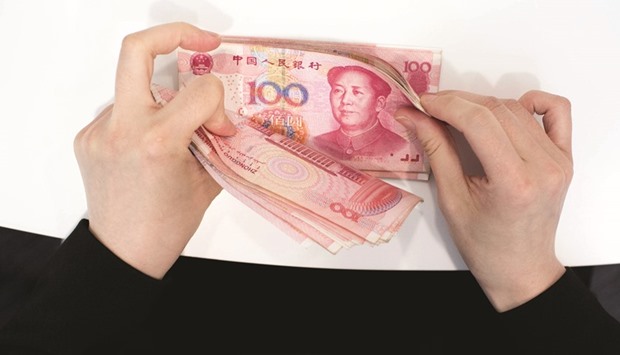Chinese companies that rushed to the exit from the US dollar bond market have few regrets. They’ve cut borrowing costs by about half while avoiding risks from a slumping yuan.
Firms from the nation have redeemed $1.73bn of overseas notes before maturity this year, jumping from $26mn a year earlier. Five of the six companies that called their bonds were builders. Sunac China Holdings redeemed $400mn of 12.5% bonds due 2017 in January and then sold 1.5bn yuan ($230mn) of domestic bonds with a coupon of 5.2%. Future Land Development Holdings bought back $200mn of 10.25% 2018 notes last month after it issued 3bn yuan of onshore notes at 4.5%.
The yuan’s four-year advance through 2013 prompted companies restricted from domestic markets to borrow dollars offshore and invest in higher-yielding developments in China’s booming economy. Those liabilities are now being unwound after the yuan dropped 4.3% in the past year and the central bank slashed interest rates in response to the slowest economic expansion in a quarter century. Corporate bond sales onshore have almost doubled this year, as offshore issuance in the greenback dropped 32%.
“Given the uncertain outlook for the yuan and cheap onshore interest rates, it makes sense for Chinese companies to turn onshore for funding, especially for developers,” said Zhou Hao, senior economist at Commerzbank in Singapore. “The trend is likely to continue.”
KWG Property Holding, a Guangzhou-based developer, said in its 2015 annual results that it capitalised on policy changes that allowed property companies to sell bonds onshore and issued 3.3bn yuan of domestic notes in December. Its 2.2bn yuan six-year onshore securities sold in December pay a coupon of 4.94%, compared to the 8.25% on $400mn bonds sold in 2014. “The new issuance will enhance the Group’s financial position to effectively improve its structure and lower borrowing costs,” it said.
Hopson Development Holdings said last week it would redeem its $300mn 9.875% notes due 2018 on March 17 at 104.9% of the principal amount.
“More Chinese companies are rushing to redeem their offshore bonds,” said Raymond Chia, the Singapore-based head of credit research for Asia excluding Japan at Schroder Investment Management Ltd with assets of about $446.5bn under management. “They have lower funding options such as refinancing existing dollar notes with a cheaper dollar debt, and other funding alternatives such as domestic bonds.”
Yields on top-rated five-year onshore corporate notes have dropped 92 basis points in the past year to 3.3% whereas yields on Chinese companies’ offshore high-grade dollar notes have risen 2 basis points to 3.39%.
“Onshore companies have been able to take advantage of cheaper onshore bond market to retire offshore bonds which tend to be more expensive,” said Clement Chong, a Singapore-based credit analyst at NN Investment Partners, which managed $202bn globally as at September 30.
Right now Chinese companies are able to issue onshore notes at coupons on average 3 percentage points lower than comparable offshore dollar bonds, according to Jamie Tadelis, head of sales at SC Lowy in Hong Kong.
The yuan is likely to weaken to 6.7 against the dollar by the end of 2016, according to the median forecast by Bloomberg.
Goldman Sachs Group said in a January 26 note there were $550bn of outflows in the second half of 2015, and that every 1% yuan weakening risks $100bn more. Chinese companies’ total foreign-currency debt dropped by about $140bn in the second half of 2015 to $1.69tn, including corporate borrowing from onshore banks, Goldman wrote in the note. China’s foreign exchange reserves shrank $99.5bn in January, the second-biggest drop on record, to $3.23tn.

A Standard Chartered employee counts Chinese yuan banknotes at one of the bank’s branches in Hong Kong. The yuan’s four-year advance through 2013 prompted companies restricted from domestic markets to borrow dollars offshore and invest in higher-yielding developments in China’s booming economy.


